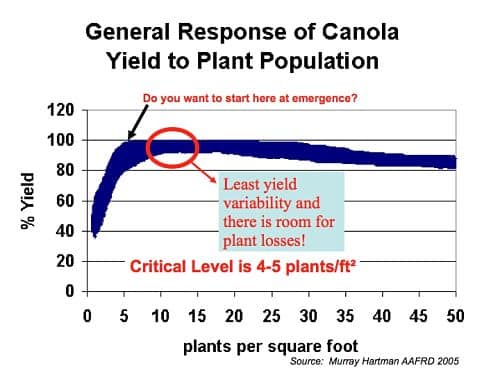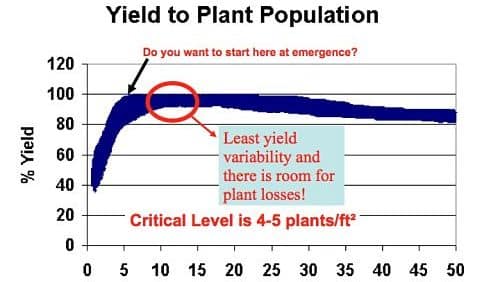Thin and uneven stands are common this year — and for a variety of reasons. Many stands have fewer than 4-5 plants per square foot with staging from cotyledon to 3-leaf.

The minimum critical plant population for canola is 4-5 plants per square foot. At that level, canola can still yield 80-100% of an ideal stand. The Canola Council of Canada suggests a target of 7-10 plants per square foot to allow for some plant mortality. Stands of 1-4 plants per square foot can provide a reasonable yield that will often outperform a late seeded crop with higher plant density, but this is not an ideal target. These thin stands need extra attention all season long, may require more crop protection investment than an ideal stand, and will likely mature later.
Step one with a thin stand is to determine the cause so it can be prevented next year. Cold soils, dry soils and frost will thin a stand, but so can insects, diseases, and equipment issues like worn openers, seeding too deep, seeding too fast and using seeding rates that are too low.
Step two, growers have to take extra care to protect the stand from insect damage and weed competition.
Manage insects: The lower the plant density, the fewer insects needed to reach the action threshold for control. For example, canola in the Canola Council’s Canopy Manipulation Trial in 2002 at Yorkton, Sask., experienced moderate to severe flea beetle pressure. Treatments with an average of 2-3 plants per square foot reached the action threshold of 25% defoliation 8 days after emergence. Treatments with 8-9 plants per square foot reached the action threshold at 20 days after emergence. Crops with low plant densities require more frequent and intensive scouting for insects at all plant growth stages.
Manage weeds: Weeds can dramatically reduce yields through competition with the crop for light, moisture and nutrients. Depending on weed type, density and stage of development, yields can be reduced by 5% to over 50%. Removing stress from early weed competition early is essential, but a second application may also be required if the thin stand takes a few weeks to reach canopy closure.
Assess the sclerotinia stem rot risk: Because thin stands have more branches per plant, this extends the flowering period and the risk window for sclerotinia infection. However, the thin stand may reduce the sclerotinia risk in other ways. The fungus needs high humidity and free water to be able to move from the petals into the leaf and stem material, therefore if the plant stand is thin enough not to have a high relative humidity, the risk of stem rot will likely not be increased even with an extended flowering period.
Prepare for delayed maturity, harvest difficulties, and fall frost: Extra branching that you get with a thin stand can delay seed maturity up to 21 days depending on environmental conditions. This delay raises the fall frost risk, which can result in a more challenging harvest and lower quality.

